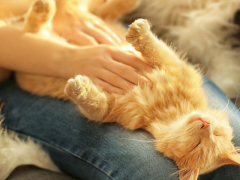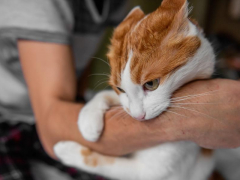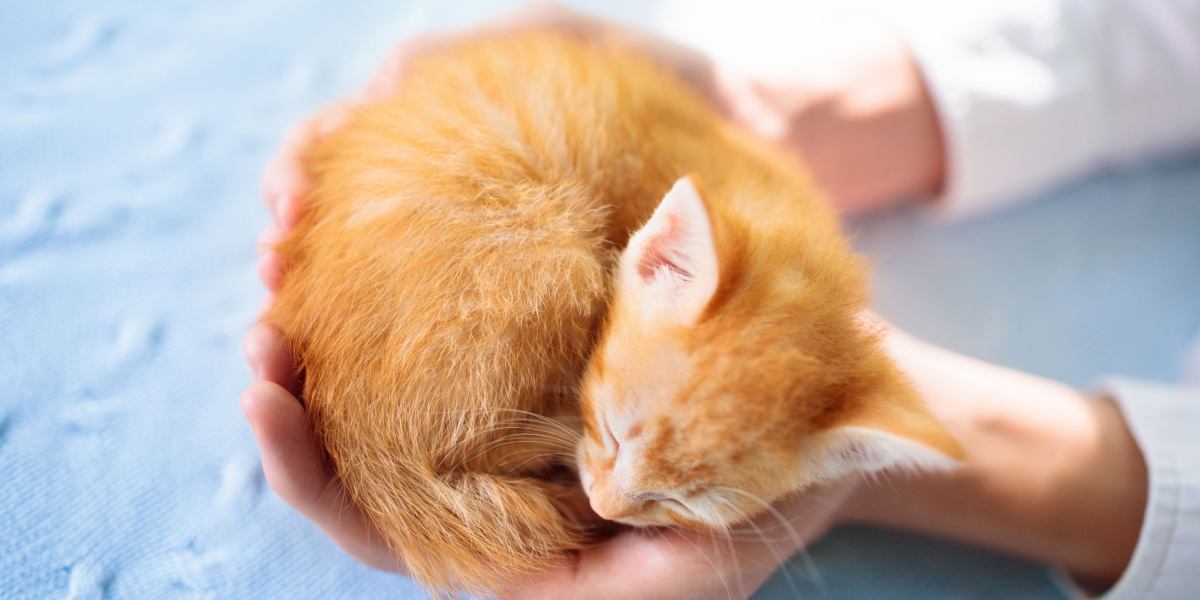
Sleep is fundamental to cats since it replenishes energy and necessitates the next short burst of high energy-consuming pursuit. As a result, domestic cats sleep between 12 to 18 hours per day and even longer as they mature.
Cats need to nap in quiet, secluded places within the home. For most cats, warmth, elevation, seclusion, and safety are essential features of sleeping cat behavior.
A cat’s sleeping position, location, and whom they sleep with can tell us how they feel and reveal information about their health and overall welfare.
Let’s explore how cats bond with their owners and what makes them choose their favorite co-sleeping partner.
Cat Bonding
Cats usually bond with one person within the household rather than multiple individuals.
Positive experiences during early socialization through daily interactions in kittenhood will pave the way to forming a close bond with a particular person. Equally, an unwell kitten who requires special treatment will develop a long-life attachment to their caregiver when provided with ongoing care.
According to research published in the Current Biology Journal, some cats form strong emotional attachments with their caregivers, like those that dogs and children develop. Most cats depend on their owner for security when stressed or in a novel environment.
Your cat’s temperament, health status, and home environment, along with your personality, all play a fundamental role in forming deep bonds with your cat. Given time, choice, predictability, familiarity, routine, and a sense of control over interactions plus environment, a cat will become attached to their owner quicker than an impatient caregiver or one that forces interactions.
When a cat is attached to their human, they tend to follow their companion from room to room. They are inclined to seek the owner’s attention by approaching them and meowing or pawing at them. Leg rubbing, head butting, purring, and napping on you are all signs that you are their favorite person.
To develop a close bond, call your cat when it’s feeding time instead of leaving food out all day. Play with your cat regularly and invest time in a daily grooming schedule as long as they enjoy brushing. Clicker training is another excellent way to stimulate your cat’s mind and enhance your strong bond.
What Does Social Sleeping Indicate in Cats?
Social sleeping in pet cats isn’t remarkable, as kittens snuggle up to their mother and littermates early on in life. Cats that have lived together since kittenhood or developed social affiliation at a young age will also display social sleeping behavior.
Resting and sleeping close together, usually touching, occasionally wrapped around each other, indicate social bonding and a close relationship between felines. In a domestic setting, cats from different social groups or those who don’t get along will often sleep in the same areas but maintain a distance, revealing that they only tolerate one another.
Ultimately, a cat that chooses to sleep with another pet or its owner socially indicates that they feel content, safe, and happy. So let’s explore how cats choose their favorite sleeping companion.
How Do Cats Choose Their Favorite Person To Sleep With?
There are several motivators for how cats choose specific people to nap with; let’s examine them in detail.
The Primary Carer
Many cats gravitate towards snoozing with their primary carer, who understands species-appropriate behavior, regularly feeds their meals, provides their daily needs, and takes them out for harness and leash walks. They also like to slumber with a companion that spends time engaging in predatory behavior through play and gives them undivided attention.
The Person That Offers Protection
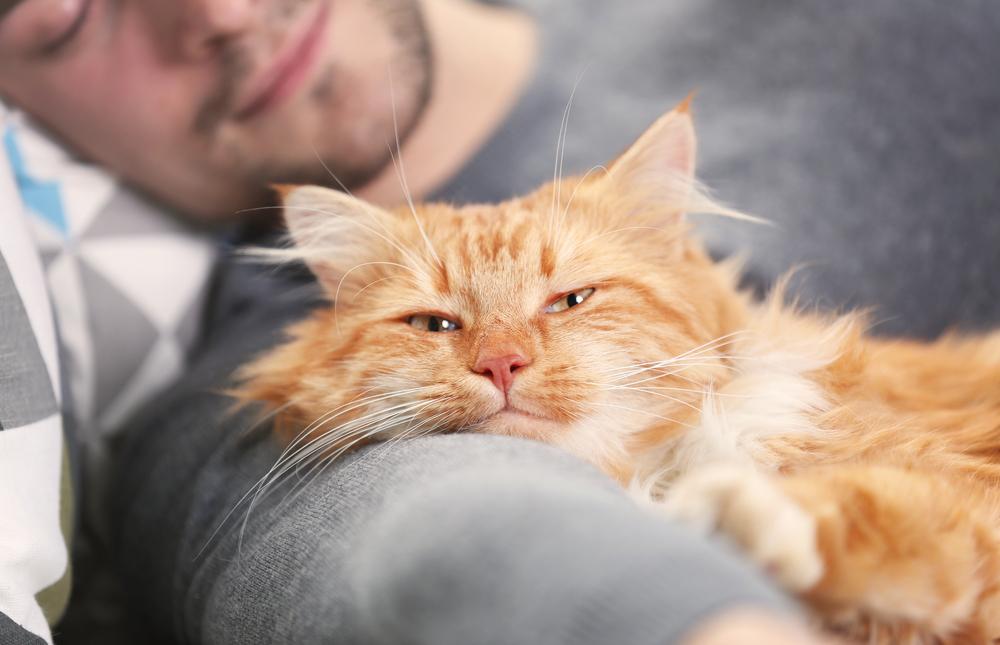
When a cat feels safe and secure, they are able to relax.
Safety and security are paramount to felines since, in the wild, they are both predators and prey. A cat will choose to nap up high on the bed with the person they feel most protected with. The risk of attack while they are asleep represents a severe survival threat.
The Individual They Are Bonded With or Attached To
Naturally, cats develop strong attachments to people like children, though cats get attached to one individual for their entire life. A bonded cat will follow their favored human, solicit attention or sleep on them any chance they get as a security blanket.
The Human That Provides Them With Warmth
Cats crave warmth since they descended from the desert and need heat for survival.
Warmth is also vital as newborn kittens lose heat very rapidly. The queen uses her body heat to keep her offspring warm, while kittens regularly huddle together to regulate their body temperature until they are a few months older.
Similarly, your adult cat will seek out the person they can lay or snuggle with that will produce the most body heat and security. Sleeping beside you, next to you, or on top of your head is a sure way to generate direct heat.
The Companion That Smells Familiar
Felines are explorative animals that use their sense of smell to decipher whether they are pleasant or aversive, of relevance or not. Since cats can recognize people by their scent, they may want to facial rub and doze off next to a familiar person to maintain social cohesion and mark their territory.
The Caregiver That Provides Reassurance During Bouts of Anxiety
A highly distressed or confused cat may choose to rest or sleep next to a caregiver that comforts them during bouts of anxiety through gentle stroking and touch.
Likewise, a cat with moderate or severe separation anxiety will curl up on the couch or bed next to the person they are firmly attached to during catnapping sessions.
Why Does My Cat Like To Sleep With Me and Not My Husband?
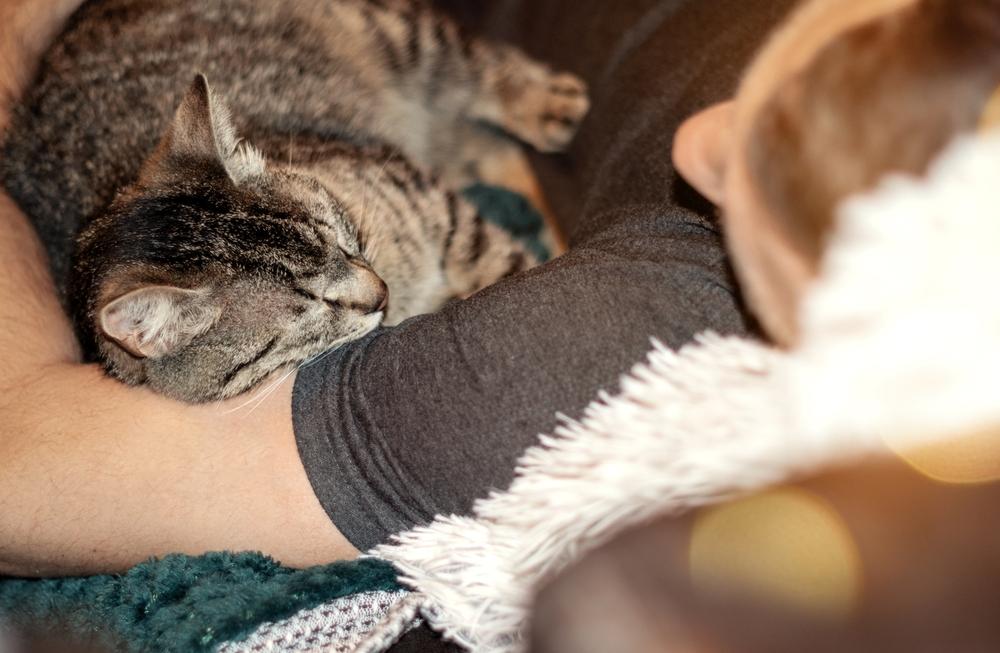
A snorer or someone who tends to toss and turn is no fun for a cat to sleep next to! They will choose a sound sleeper instead.
A cat instinctively wants to sleep with the person they have a strong connection to. Cats get attached to one person and usually gravitate towards a primary carer who feeds them, plays with them, and provides them with much attention.
Another reason your kitty prefers to sleep next to you is because you provide warmth and security. Equally, your side of the bed is a great vantage point and leaves plenty of space compared to your husband.
Lastly, if your husband, snores, tosses and turns, or wakes up several times at night, causing your cat discomfort, your cat will be inclined to sleep next to you since you’re a sound sleeper.
Should You Let Your Cat Sleep With You?
Allowing your cat to sleep with you is a personal choice.
There are several health benefits to a lovable cat purring with contentment while you’re falling asleep, from stress reduction and lower blood pressure to strengthening your existing bond. Then again, there will be times when you may prohibit or reduce snooze time with your cat due to allergies, breathing issues, exposure to parasites, or night shenanigans affecting your sleep quality.
To minimize bedtime deprivation and get a good night’s sleep read 11 tips to train your cat to sleep all night
Final Thoughts
Sleep is an essential behavior for felines and humans. Like people, cats prefer to snooze with the person that makes them feel loved, warm, and secure. A sudden change in your cat’s sleep pattern, location, or with whom they sleep can indicate distress or ailment. Consult your veterinarian to ensure early detection with appropriate treatment.
Also Read: 9 Cat Behavior Changes To Worry About
-
Atkinson, T. (2018). Practical Feline Behaviour. Wallingford, Oxfordshire, UK: CABI. Retrieved January 25, 2023
-
Care, I. C. (2020, September 01). Module 5 Creating a cat friendly home. International Cat Care Advanced Feline Behaviour for Vet Professionals. UK. Retrieved January 19, 2023
-
Kristyn R. Vitale, A. C. (2019, September 23). Attachment bonds between domestic cats and humans. Current Biology, 29(18), PR864-R865. doi:https://www.cell.com/current-biology/fulltext/S0960-9822(19)31086-3
-
Smith BP, H. P. (2017, September 28). A Multispecies Approach to Co-Sleeping : Integrating Human-Animal Co-Sleeping Practices into Our Understanding of Human Sleep. PubMed, 255-273. Retrieved January 26, 2023, from https://link.springer.com/article/10.1007/s12110-017-9290-2


